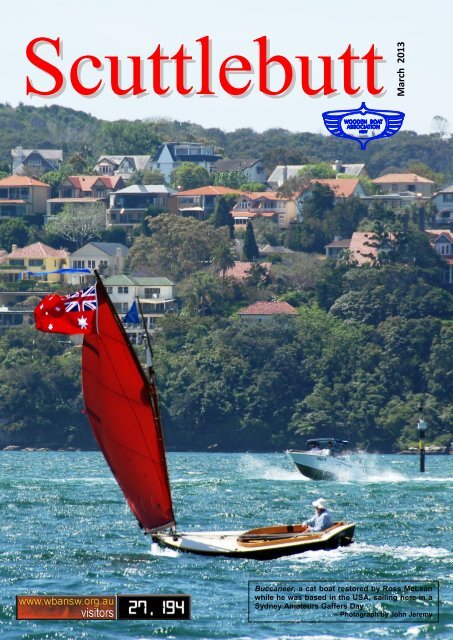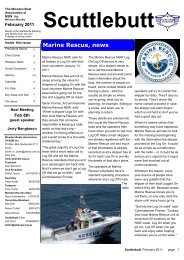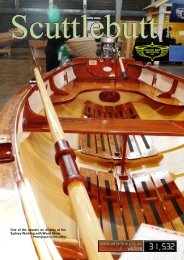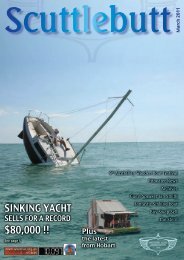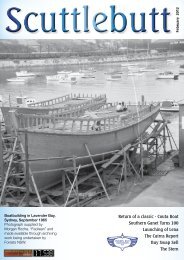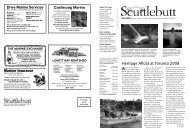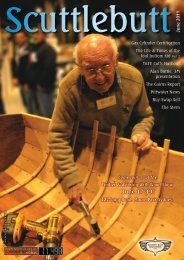March 2013 - Wooden Boat Association NSW
March 2013 - Wooden Boat Association NSW
March 2013 - Wooden Boat Association NSW
You also want an ePaper? Increase the reach of your titles
YUMPU automatically turns print PDFs into web optimized ePapers that Google loves.
<strong>2013</strong>Scuttlebutt <strong>March</strong>1Buccaneer, a cat boat restored by Ross McLeanwhile he was based in the USA, sailing here in aSydney Amateurs Gaffers Day.– Photograph by John Jeremy
^ Presidents ReportPredicted survival time in water @ 10 o C without a lifejacketis 1.5 hoursWearing a lifejacket may increase survival time to:1 No increase in time, but better chance of not drowning2 2.5 hours3 4 hoursRoss McLeanAs our erstwhile President was gallivanting and swanning about inHobart, it behoves our Vice President to do a bit of a report on lastmonth’s meeting. We also look forward to having a full report ofthings Taswegian from our President in due course.Our Trivia evening generated much conversation and was enjoyed byall, plus the introduction of a new member who apparently owns anex-army boat. This of course caused our young Don Roberts to leavehis seat on several occasions to communicate ‘things nautical’ aboutmilitary vessels, during the course of the evening.The conversations flowed back and forth about navy and army boatsamong those present for a good while.With regards to the trivia quiz, two slides that generated muchdiscussion were:The following graph is from a publication by the Australian MaritimeAuthority, (AMSA), and titled “Survival at Sea”. The graph shows thatthe predictedsurvival time isless than threehours in waterof 10 0 C.Of interest,none of the1489 personswho remainedin 0 0 C water atthe sinking ofthe Titanic in1912 was alivewhen rescuevessels arrived1 hour 50minutes later;almost all thosein lifeboatssurvived.Also from the publication by the Australian Maritime SafetyAuthority, (AMSA), “Survival at Sea”.APPENDIX ABURIAL AT SEAUnless death occurs after contact with search aircraft or ships, any deadperson should be buried at sea. To keep a body or bodies in survival craft isunhealthy and will badly affect morale. A record should be kept of anysuch burials.Dead people should be stripped of any clothing which may be useful forwarming the living. Personal effects should be kept and handed to theappropriate authorities when rescued.Other interesting questions were those about the ‘Cardinal MarkSystem’, which caused just a little confusion, so I thought I mightclarify that here as well...Below is a simplified diagram showing their use, and it may interestyou to know that at one point, MSB when <strong>NSW</strong> Maritime was sonamed, was actually considering the introduction of this form ofmark to replace the current ‘Lateral Mark’ system. I, like many others,opposed the move and it was dropped thankfully.The primary thing to remember is that both North and SouthCardinal Marks point to the side you should be on, e.g. north of theNorth Cardinal Mark and south of the South Cardinal Mark, (justfollow the arrows), but for the East and West Cardinal Marks, the bestway to remember them is that a West Cardinal Mark resembles awine glass, while East can be a representation of the rising sun.Again, stay east of an East Cardinal Mark, and west of the WestCardinal Mark. I hope this helps, as it helped me many years agowhen I first was introduced to these beasties.The guest speaker in <strong>March</strong> will be Mori Flapan. Mori’s presentationwill focus on the 40’ Army Workboats. These timber boats havebeautiful “Lines” and are designed as a sturdy and rugged workboat.RossThe second slide,Unless death occurs after contact with authorities, any deadperson:1 Should be stripped of their clothing which may be usefulfor the living2 buried at sea3 Go through their personal effects to see what may beuseful2
A STORY off a 40’’ WORK BOATby the editor with material from Don RobertsDon RobertsWhile contemplating retirement,Don Roberts decided to purchasean ex army or navy workboat. Donhad travelled in similar vesselswhile based in New Guinea duringthe Second World War and hadfond memories of them. (Don wasstationed in New Guinea – initiallyPort Moresby then Lae – with ananti aircraft unit from 1942 to1944. He survived 32 air raids.)In the mid ‘80s, the Defence Dept.began calling tenders for thedisposal of many of these craft.Don unsuccessfully bid on acouple before determining thegoing price. In 1987 he wassuccessful with two bids, numbers441 and 442. After explaining thathe only wanted one vessel, he purchased ‘442’.This is the month for workboats. Wehave Mori Flapan at our next meeting topresent ‘The 40’ Army Workboats – theirwar & peace’ and Don Roberts camealong to our February meeting with amagazine – “Australian Warship”featuring an article on defenceworkboats – Still Going Strong with apicture of his last boat.Since I had been loaned a copy of thesame magazine only a few days earlierand read the same item, I considered itwas a prompt for an article.Published ten times per year byTopmill Pty Ltd, Silverwater,<strong>NSW</strong>The vessel had not been in service for some time and had asubstantial amount of growth on the bottom; batteries and fuel hadbeen removed. Don secured the services of a diver to clean up thebottom and armed with new batteries and some fuel, he set off tosteam from Garden Island to Botany Bay and up the Georges Rivernear his home and boat shed.Restoration of the boat was over a 3 year period with only part timeeffort.The 40' Army workboats were designed by Botterill and Fraser atWilliamstown, Melbourne. The Department of the Navy issued a 15page specification on29 th December 1943.The specification calledfor extensive use ofJarrah timber for thekeel, hog, stem,deadwood, floors andengine beds. Allfastening was to becopper nails with roves.<strong>Boat</strong> as boughtIt provides an interestingread and can be found inthe National Archives.442 was built in 1944 and was one of 287. It is contended by somehistorians that 442 was built at Slazenger’s Shipyard* at Putney.Post war, many of the vessels finished up all round the Pacific Islands,Borneo and New Guinea. At least some if not all of the remainingworkboats operated by the Australian Army were given new numbersafter WW2: AM followed by a three digit number commencing with4. The 4 was a marker for a boat 40' long. While the majority of theboats were built for the army, by the late 1950s, some of theserenumbered launches had been transferred to the RAN. The Navyappear to have kept the number but changed the prefix to AWB.Hence the boat AM404, for example, became AWB404. Some sayerroneously that AWB stands for "Army Work <strong>Boat</strong>". However this isnot correct. Official correspondence from 1956 that confirms AWBstood for "Australian Work <strong>Boat</strong>".442 was transferred to the Royal Australian Navy at some time before1950, renumbered AWB442. Around November 1950 it was assignedto HMAS Culgoa, a River Class Frigate. Circa 1960s it was attached toRAN Clearance Divers, fitted out for diving with bottle racks and afold-down diving platform on the transom. From 1980-1984, it was aworkboat for the RAN operating on Sydney Harbour, capable of lighttowing & carrying up to 12t of cargo & personnel and also used asan ammunition towboat.The frames are Australian hardwood with 1¼” Oregon planking andwith a marine plywood transom. The hull is copper sheathed. Thecabin sides are of Oregon. Two bunks, a small stove and heads werefitted by Don to provide some comforts for over-nighting on theharbour.Length 40’, 12’ beam, 4.5ft draft, 10.5 tonnes displacementThe engine is a GM 6-71, 2 stroke, 165bhp, six cylinder diesel. Theinline six-cylinder engine was introduced as the initial flagshipproduct of the Detroit Diesel Engine Division of General Motors in1938. Similar engines have been installed in trucks, busses, boatsand even tanks. At a cruising speed of better than 8 knots,consumption is approximately 5 litres per hour doing 1200 – 1300rpm.Don tells me that he lifted the engine back off the bed in order toclean up 40 odd years of oily grunge in the bilge below. Evidently,the standard procedure for changing the engine oil was to drain it into the bilge and then pump out over the side. A possible scenario ina war zone, but this engine had been given a nickname - "DriptroitDiesel," referring to the powerplants' factory colour and propensityfor leaking oil on everything in or near the engine compartment.The vessel came with four copper fuel tanks that Don retained in theboat, providing a range of around 450 nm.After the restoration, Don moored the boat at Double Bay for a whileand then later secured a mooring at Half Moon Bay.He took an active part in the Bicentenary Celebrations in 1988,meeting the tall ships in Botany Bay and then travelling up to SydneyHarbour.About 3 years ago, Don passed 442 to another custodian, AndrewKnox, a member of the WBA who is continuing to provide the TLCrequired and enjoying the vessel regularly.* Editor’s note next pageA recent photo of 442 on Sydney Harbour3
Slazenger’s ShipyardIn New South Wales around 50 companies housed government annexesduring the war. One of these was Slazenger’s, a company involved in themanufacture of sporting goods. Such a luxury industry, however, had noplace in a country geared up for total war. Slazenger’s main plant was atAlexandria in inner-city Sydney. It was here that the company began itswar-time production, makingrifle and Bren-gun componentsand ammunition boxes. In anannexe adjacent to this plant thecompany made filter pads forgas respirators and at EmpireTimbers Limited in Balmain theyhandled aircraft timbers forRAAF gliders. In 1942 thecompany ventured intoshipbuilding. Although they hadno previous experience in thisfield, Slazenger’s considered thattheir specialised knowledge ofprecision woodwork made thema suitable firm for handling sometypes of small ship fabrication.In January 1943 Slazenger’sleased six acres of waterfrontland on the Parramatta River atPutney, and by <strong>March</strong>production was under way, withan initial group of 41 menengaged in fabricating 45 footplywood punts for the UnitedStates Army. These weredestined for use in the Pacific, where small craft were playing anincreasingly important role. Towards the end of 1944 work began at thePutney site on an order for motor scows for the RAAF. They too weredestined for the war in the Pacific. Six were completed and another 27were in production when the war ended in 1945. The shipyard closedwith the end of the war and the buildings were demolished.Based on a series of highly popular articles written forClassic <strong>Boat</strong> Magazine, this witty collection recalls someof the incidents the author has survived in over half acentury of messing about in boats.Most sailors will find something to relate to in theseescapades from around the world and they will bring awry smile to any boaters lips. Theauthor’s wonderfully witty cartoonshelp bring these anecdotes to life.All these stories are true so WBAmember Alan Williams writesunder a pen name so that hisarchitectural clients do not thinkthey are entrusting their work to a seagoing Mr Bean. Copiesare available from <strong>Boat</strong> Books in Crows Nest at $24.95 or lesson Amazon. WBA members can get copies from Alan at meetings for $ 20.ON THE HORIZONTHIS YEAR <strong>2013</strong><strong>March</strong> 12 WBA Meeting, guest speaker, Mori Flapan, ‘The 40’ Army Workboats – their war & peace’<strong>March</strong> 30 - 31 Lake Macquarie Classic <strong>Boat</strong>fest, Toronto http://www.classicboatfest.com.au/April 9WBA meeting – Guest speaker Ian Smith ‘Risør <strong>Wooden</strong> <strong>Boat</strong> Festival – Norway’.May 14WBA meeting – Guest speaker Angelia Catterns – ‘<strong>Boat</strong>s of my life’.June 11 WBA meeting – Presentation by the winner of the Hal Harpur Award 2012.July 9WBA meeting – tbaAugust 13 WBA meeting – Guest speaker John Diacopoulos ‘From Workboat to Day boat’.September 10 WBA meeting – to be advisedOctober 8 WBA meeting – Guest speaker John Wood ‘The WBA Love Affair of 1990’.November 2-3 Timber <strong>Boat</strong> Festival, RMYC, Pittwater. http://www.royalmotor.com.au/November 12 WBA meeting – Annual General MeetingNovember 15–17 Narooma <strong>Boat</strong>sAfloat FestivalDecember 10 WBA meeting – Hal Harpur Award winner/end of year dinner <strong>2013</strong>.NEXT YEAR 2014January 14 WBA MeetingFebruary 11 WBA Meeting4
BUY SWAP and SELLWBA members may place a non-commercial ad freeof charge if the member’s name and phone no.appear. Non-members are charged $20 for a text ad(maximum 25 words). $30 with a picture. Ads will runfor two issues, members ads longer if you ask for anextension. Submissions close on the 21st of eachmonthNOTE: Items for free, No Charge. Contact the Editor,see page 5 for details.Valued at $800 a few years ago but I thinkthat was a tad optimistic.Have a look, have a wine and make an offer.Epping. David Verity 0407 111 123FOR SALEBella is one of the Couta fishing boats builtFOR SALEFOR SALEJLH, as featured on front cover ofScuttlebutt, Aug. 2011Built by President Shipwright Services atDrummoyne – basically a replica of Cinema,the first licensed fishing boat in <strong>NSW</strong> - asfeatured in the WBA publication, Australian<strong>Wooden</strong> <strong>Boat</strong>s.LOA 18ft, beam7ft. Draft 2½ft.PlankingRichmond Riverpine on SpottedGum timbers.Sole 13 HP, 2 cyl.diesel, with 60litre tank. Cuddycabin. $29,500 orbest offer.Phone John or Peter on 02 9181 3467FOR SALE5Vintage metal latheon stand withflywheel and lots ofbits. May havebeen a treadlemachine but nowhas motor (notfitted).Suit someone whounderstands thesethings (not me!)by Alex Lacco for commercial use in PortPhilip in the 1950’s. She has beenrefurbished and well preserved and has beenin Sydney for 25 years. She is a round bilge6.2m launch with transom stern and smallcabin house. Hull is reported to be kauriwith plywood deck, and small Oregon signalmast.Inventory includes: Original Volvo twincylinder diesel MD7A, Life jackets, mooringlines, fenders, running lights, electric bilgepump, boat hook, danforth anchor andchain, cockpit storm cover etc.A classic not to be missed.HIN is AU – WWA 063258D79 Maritime<strong>NSW</strong> # AAM639Nnow $13,950 or offersContact Nigel Stoke 02 9922 4355 /nigel@stoke.net.au“ZENA” International 12 Square Metre“Sharpie”. Length 6.0m, Beam 1.4m, Sailarea 12m 2 . Built Victoria, circa 1950.Restored in 90’s with new deck and mast. Asnew galvanized trailer (manf. 2011).Occasional competitor in the SydneyAmateur Sailing Club’s Gaffers Regattassince early 1980’s. Winner of Div. 2 in 2011.A great chance to buy a traditional racinggaffer which is sweet to sail and easy toupkeep. Selling with reluctance, but I needto rationalise my wooden boat fleet!$5,000 including trailer. Located Sydney.Malcolm Boyd 0412 797 479msboyd@ozemail.com.auFOR SALEThe perfectproject for anAlbertStrange fanThe StrangeLady islooking for anew owner.The boat iscomplete butrequiresfinishing off.She is a 25 ftyawl, gaffmain with alug jigger.She’s never seen the water. We are lookingfor offers round $18,000.Grant 0400 844 716FOR SALEHal Harpur`sIrex 11A Classic 33ft1934 FriendshipSloop. Sound andseaworthy.Freshly paintedand antifouled.Comfortablecruising. $43,000.Neg. locatedTweed River.Email charlespecats@bluemaxx.com.au
Buccaneer is a 1942 gaff rigged, cat boatfrom the USA which was restored in 2002 byRoss McLean just prior to his return toAustralia in 2003. It is 14 feet overall by 6foot 6 inches wide in the old measure.Buccaneer has a single gaff rigged sail inexcess of 100 square feet in area supportedby a mast that is stepped near the bow,hence, ‘cat boat’ for cat rigged. She isconstructed of teak planking on an oakBUCCANEERfrroom f RRoossss MccLLeeaannframe, and Ross used white oak from hisown U.S. property around the centre-boardcase during the restoration.The boat first came to Ross’ attention whenhe was asked to salvage it from under themud of Long Island Sound, near BranfordConnecticut, for its owner. (The very factthat most of it was buried probably savedthe boat). Once raised, he conveyed bothboat and owner to the Haddam <strong>Boat</strong> Worksin Connecticut run by shipwright, FredHarrington. Once there, Fred made anestimate of repair costs which came out tobe many thousands of dollars, mostlylabour. This was now too expensive for theowner, who owed Ross a large sum ofmoney for the salvage and other workundertaken on the owners other 4 boats, soRoss offered to wipe the debt if he couldhave the boat.That agreed, Ross set about restoring thevessel to its former glory. It took almost ayear of part time work, with the boatfinished, minus mast and spars. At the startof the process, Fred pointed out that thecentre-board case looked a bit suspect, andadvised Ross to give it a whack with arubber mallet. Ross complied, but Fredinsisted that he give it a harder whack. Rossrepeated the application of the mallet withmuch more gusto … the centre-board casegave a resounding “crack,” and split in two.“Yep! Got a bit o’ work to do there alright!”replied Fred, to the look of horror on Ross’face. After that Ross had to replace the case,remove the old canvas deck covering, andstiffen the deck itself. During this process itwas determined by Fred, based on thefasters used and the plywood of the broken6centre-board case, that Buccaneer wasprobably constructed in 1942 or thereabouts. The fasteners were first introducedin 1942, but withdrawn some months laterfor the war effort and the plywood was prewartype. So … best guess was 1942, as notmuch plywood of the older type was beingused after the war because of the advancesin ply, glue technologies, and the old typebeing fairly useless by comparison.Perhaps the most amazing part of the entireprocess was when the new canvas coveringto the deck was applied. This is done toprovide a non-slip surface on the foredeckof traditional boats on the U.S. East Coastwhere Ross was located.There was a 45 foot plus ketch to be done,and a 35 foot something cat boat, plusBuccaneer. All scheduled for the same daywith a visiting canvas steaming team. Withthe aid of some friends of Fred’s and Ross’,the team steamed up and covered the ketch,then using the cockpit cut-out from the bigboatand a little extra canvas, they laid thecanvas on the 35ft cat boat. After that,using the cockpit cut-out of the bigger cat,they covered Buccaneer. The steaming teamdid the steaming and initial stretching andtacking, while the lackeys finished thetacking, and applied the first coat of oilbased paint. The paint acts to drive out themoisture, and helps the canvas shrink andconform to shape.Buccaneer was later finished in oil basedpaint, with hunter green for the hull, andbeige on deck, inside and out.Upon completion, the former ownerstopped by to admire the work, and boughtalong the mast and spars, later the formerowner’s son turned up with a sail, but onlyafter Ross had had one made based on themast height and length of spars. Both sailsFinal coat on hull and boot stripewere as near as could be identical in size.Buccaneer gets her name from Ross’ son’sfavourite pirate joke …“How much does a pirate pay to have hisears pierced?” … “A buck-an-ear” …Buccaneer was launched in New HavenHarbour to much fanfare, washed down withliberal amounts of bubbly which justhappened to be the J.Roger brand fromFrance. Could the ‘J’ stand for jollie?Then there was the issue of ‘what flag to fly?’A friend told Ross he couldn’t fly the ‘Stars& Bars’ as he wasn’t, (and still isn’t), a yank,and he’d be fired upon if he flew that Limeything, (Union Jack). So they gave him thefirst Colony flag for the Americas, the EastIndia Company flag, and so that is whatBuccaneer can sometimes be seen flying.Later, Buccaneer was displayed in front ofseveral West Marine chandlery stores whereRoss was an assistant manager. He workedmainly in Branford, but was occasionallyasked to be relief manager at stores such asMystic, near Mystic Seaport, New London, orOld Saybrook, all in Connecticut. Buccaneerhighlighted the products used from WestMarine for the restoration. On one suchoccasion, the fellow shipping Ross’possessions to Australia stopped by, (he wasa regular customer), and asked Ross what heintended doing with the boat? ‘Sell it, Isuppose,’ was the answer Ross gave.“Sell it? Don’t be silly, ship it down-under,and I’ll let you have a bigger container. Thatway Sally can take some of her furnituretoo,” he replied. That settled, Buccaneerheaded south by sea, albeit in a box, as wellas Sally’s antique wardrobe and chest ofdraws.Buccaneer can now be seen at many WBAgatherings including the Working with Wood
Show, Lake Macquarie, and Pittwater events,and is often seen sailing on Port Hacking,but beware. If you decide to approach wesuggest you keep in mind that Buccaneerdraws two feet with the centre-board downand ten inches with it up.THE HOBART TO CAIRNS REPORTSo many miles, so many places, so manyeter Smithpeople. I can do justice to the miles and theplaces but I am a poor host. Gilli had flownoff to Germany at short notice for a funeraland Westwind was like a dove with a brokenwing. Poor Gilli missed the festival and acruise down the channel to Cygnet andFranklin. Luckily we had already sailed downchannel when we first arrived and enjoyed aweek in company with Austin Roper, theTasmanian that once went to Queensland.The D'entrecasteaux Channel is a wonderfulcruising ground and I was surprised to findthat Westwind had left 180 miles of itbeneath her keel before we made our finaldeparture from Hobart. This departure wasspecial in a couple of ways; it was the firsttime we had a favourable wind downchannel and it would mean that we wouldbe breaking new ground. The James Craigwas rescued from the mud of Recherche Bayat the southern end of D'EntrecasteauxChannel. The bay has the unfortunate nameof Pigsties Bay and this is where weanchored while a strong wind blew itself out.Early the next morning we hopped on thetail end of the blow and sailed clean aroundthe bottom of Tasmania and I still can'tbelieve we did it! I do know from therecords that Westwind has been around toPort Davey before, 75 years ago. PortDavey, Bathurst Channel and BathurstHarbour were formed 7000 years ago and itwas all caused by global warming and a risein sea level.We were so lucky to have a fine sunny daywith a moderate westerly breeze to enterBathurst Harbour. The East Pyramids, BigCaroline and Breaksea Island are finesentinels but when we opened BathurstChannel, which is narrow and winding, weentered another world. The channel is about8 miles long and over 35 metres deep inplaces even where there is flat ground oneither side. The water is the colour of teaA point a rascally jet ski did not take intoconsideration, and so far as we know, thechap’s jet ski is still stuck in the mud offPort Hacking!from Chris & Gisela Dickerfrom the seepage and flow of water throughthe button grass and peat from thesurrounding mountains. I can honestly sayMelaleuca Marinathat it is one of the most beautiful stretchesof water I have ever been to and to share itwith Gilli made it all the more fulfilling.There is a place here called Melaleuca, Iwalked here years ago when my knees weregood, they are still good enough. Westwindanchored in a little muddy bay calledClaytons Corner from where we could lookright up Melaleuca Inlet. It is anotherchannel in this fascinating system. In theend it became just too fascinating and weup anchored and wound our way right up toMelaleuca, where we tied up at the marina.NOTORIOUS was in the Australian <strong>Wooden</strong><strong>Boat</strong> FestivalThis is a truly historic area and we were ableto walk amongst the ruins of peoplesstruggles. None of these struggles werewithout reward though, they bred toughcharacters that enjoyed and appreciated arich life.Our next destination was MacquarieHarbour and our overnight sail there wasmade magic by a full moon and a calm sea.We arrived at Strahan just in time toreprovision and take in the town. It hasbecome a southern Hamilton Island exceptwith about 400 times more flavour....and alittle cooler!From here we hope to head down harbourand up the Gordon River. We would alsolike to sail back across Bass Strait but thereare rumours that the weather is terrible overthat side.!!Letter to the EditorBrass woodscrews. I got most frustrated notbeing able to buy anybrass wood screwsunless I bought awhole box of 250pieces. I only needed24. At the Hobart<strong>Wooden</strong> <strong>Boat</strong> Festival I met a fellow fromQueensland who wore a T-shirt with thewords Bronze and Brass Fasteners. He saidhe has brass woodscrews and sells ANYquantity. True to his word a few days later Ireceived my 24 screws and at the sameindividual price as the box price (and thatincluded postage!)If you need brass screws, try this fellow:Anthony Cowan, phone: 07 5641 1860email: sales@bronzeandbrassfasteners.com.auHope it helps somebody.Kind regards,John WagemansDid You Know?The WBA of <strong>NSW</strong> receives a complimentarycopy of Steam Leak from the Steam <strong>Boat</strong><strong>Association</strong> of Australiaeach quarter. The Steam<strong>Boat</strong> <strong>Association</strong> ofAustralia is a non-profitorganisation consistingof people with a keeninterest in steam drivenvessels of all types, largeand small, old and new.The SBAA also meetsquarterly at the Gladesville Sporties Club. Anumber of members of the WBA are alsoSBAA members. As their Secretary, TerryLance has stated, “There can be no bettermarriage than a classic steam engine in abeautiful wooden boat.” An open invitationis extended to any member of the WBA toattend these meetings. The WBA also mailsout a copy of Scuttlebutt to the SBAA eachmonth.See http://www.steamboat.com.au7
Our page 8 story................When we received the letter from John Wagemans re thesourcing of brass screws, (see previous page), we figured thescrews were for something nautical...John has built or restored about 40 wooden boats. This latest is an IanOughtred design, AUK, 7'10" LOA in Huon pine.“Construction is strip planking . The intention is to finish it in clear varnish (2pack) except for the bottom up to the waterline in white, as well as the insideunder the floors. I still have quite abit to go. All the inside varnishing,fastening the seats, then turn overand fibreglass the hull so the Huonpine will show clearly. Then to make the mast,boom and yard................”Was this a project to use up the Huon pineyou were attempting to sell in Scuttlebutt?“Yes, that was to use up the Huon pine”An appealing project, John - editorDisclaimer: Opinions and advice expressed in this publication and the <strong>Association</strong>’smeetings are those of the individual originator’s only. The Editor and the <strong>Association</strong>’sCommittee do not necessarily endorse views expressed at such forums. Participation inevents organized by the <strong>Association</strong> may involve certain risks which include the possibility ofharm or damage to vessels, equipment or persons inherently associated with the perils of thesea or weather. Such risks will require the exercise of the prior judgment of members onbehalf of themselves, their guests and invitees whether to commence or continue anyparticular activity irrespective of information supplied by <strong>Association</strong> officers.8


